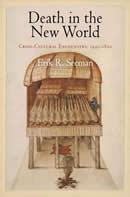2010
Baroque Horrors
Roots of the Fantastic in the Age of Curiosities
David R. Castillo
The University of Michigan Press, 2010
Baroque Horrors turns the current cultural and political conversation from the familiar narrative patterns and self-justifying allegories of abjection to a dialogue on the history of our modern fears and their monstrous offspring. When life and death are severed from nature and history, “reality” and “authenticity” may be experienced as spectator sports and staged attractions, as in the “real lives” captured by reality TV and the “authentic cadavers” displayed around the world in the Body Worlds exhibitions. Rather than thinking of virtual reality and staged authenticity as recent developments of the postmodern age, Castillo looks back to the Spanish baroque period in search for the roots of the commodification of nature and the horror vacui that accompanies it. Aimed at specialists, students, and readers of early modern literature and culture in the Spanish and Anglophone traditions as well as anyone interested in horror fantasy, Baroque Horrors offers new ways to rethink broad questions of intellectual and political history and relate them to the modern age.
Death in the New World
Cross-Cultural Encounters, 1492-1800
Erik R. Seeman
University of Pennsylvania Press, 2010
Reminders of death were everywhere in the New World, from the epidemics that devastated Indian populations and the mortality of slaves working the Caribbean sugar cane fields to the unfamiliar diseases that afflicted Europeans in the Chesapeake and West Indies. According to historian Erik R. Seeman, when Indians, Africans, and Europeans encountered one another, they could not ignore the similarities in their approaches to death. All of these groups believed in an afterlife to which the soul or spirit traveled after death. As a result all felt that corpses—the earthly vessels for the soul or spirit—should be treated with respect, and all mourned the dead with commemorative rituals. Seeman argues that deathways facilitated communication among peoples otherwise divided by language and custom. They observed, asked questions about, and sometimes even participated in their counterparts’ rituals. At the same time, insofar as New World interactions were largely exploitative, the communication facilitated by parallel deathways was often used to influence or gain advantage over one’s rivals. In Virginia, for example, John Smith used his knowledge of Powhatan deathways to impress the local Indians with his abilities as a healer as part of his campaign to demonstrate the superiority of English culture. Likewise, in the 1610-1614 war between Indians and English, the Powhatans mutilated English corpses because they knew this act would horrify their enemies. Told in a series of engrossing narratives, Death in the New World is a landmark study that offers a fresh perspective on the dynamics of cross-cultural encounters and their larger ramifications in the Atlantic world.
Mapping Intermediality in Performance
Edited by Sarah Bay-Cheng, Chiel Kattenbelt, Andy Lavender, and Robin Nelson
Amsterdam University Press, 2010
This volume examines afresh the impact upon acting and performance of digital technologies. It is concerned with how digital culture combines the traditional liveness of theatre with media interfaces and internet protocols. The time and space of the here and now are both challenged and adapted, just as barriers between theatre-makers and the experiencers of events are broken down. Today many of us are everyday players performing the interconnectedness of digital culture and a key aim of the book is to unpack the multiple interrelations within the landscape of contemporary performance. Access to a range of instances (The Builders Association, Castellucci, Castorf, Gob Squad, Lepage, Second Life and VJing) is through portals which afford perspectives on the main characteristics of theatre and performance in the digital age.



